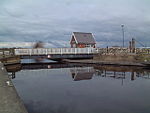Hirst Priory

Hirst Priory is an 18th-century country house in Belton on the Isle of Axholme, North Lincolnshire, United Kingdom. The current house was built on the site of a 12th-century Augustinian priory (Hirst Priory).Hirst Priory served as a family residence first for the Stovin family, and later for the Lister family in the 19th century. In 1903, the property was purchased by D. Stubley for £18,000. In the early 1990s, a development group purchased Hirst Priory in order to develop a hotel and leisure complex, but these plans were abandoned. In 2014, Hirst Priory was converted to a wedding and events venue, with renovation work carried out to ensure the preservation of the Grade II listed building.
Excerpt from the Wikipedia article Hirst Priory (License: CC BY-SA 3.0, Authors, Images).Hirst Priory
High Levels Bank,
Geographical coordinates (GPS) Address Phone number Website Nearby Places Show on map
Geographical coordinates (GPS)
| Latitude | Longitude |
|---|---|
| N 53.583 ° | E -0.8265 ° |
Address
The Lincolnshire Golf Course
High Levels Bank
DN17 4BU , Crowle and Ealand
England, United Kingdom
Open on Google Maps








